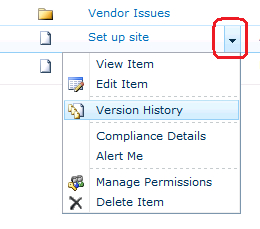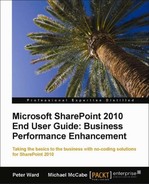In this section, you will be introduced to advanced features of lists.
When a list item is opened, the field columns are displayed in a form style page. There is the ability to add web parts and apply a mobile device page to the form. This functionality provides a richness to the form as list views can be added to a form page, which is useful if list information needs to be compared.
This functionality is covered in detail in Chapter 13.
By clicking on the List Settings icon on the Ribbon, you have the ability to manage the setting of a list.

Under General Settings, the following list of functionalities can be applied or changed:
The name, the description of the list, and the option to display the list on the Quick Launch is available.
The versioning setting provides two main functions: the ability for content to be approved before it is visible to users, and allowing version control of items. This provides you with the ability to determine who can see draft content based on the Draft Item Security setting.

Note
Versioning is really rarely used in lists and is more often used in document libraries, probably because the content is being edited more often. However, it's an important functionality to mention in this context.
To view the version history of an item, click on the downward menu arrow.
The Version History setting in a list can increase the storage capacity of the SharePoint server if multiple versions of items are saved. Often, users request that they need version control for their content, but it is often viewed as a rarely used feature.
A compromise between the requested feature and actual user behavior is to select a version limit of a few items.
The Advanced Settings allows further customization to a list such as Content Types and Permissions.
Content types were introduced in SharePoint 2007 and are content templates that can be reused in another list. Content types range from an expense document to a custom list, with defined fields relating to client information. When a list is defined to have multiple content types such as expense forms, contract, and URLs, there are user ability benefits as multiple contents can be stored in the same list. There is also a set of defined content types that are available. By using predefined content types, deployments of lists are quicker because fields are already defined, workflows already associated, although with information management policies, and document templates.
For example, suppose you defined a content type named Contract. This content type might include the following:
- Columns named Customer, Amount, and Final Effective Date
- An approval workflow
- A retention policy linked to the Final Effective Date field
- A Word template for a contract document
Content types are defined and managed at the site level, but they are typically defined at the root site in a site collection. In order to use a content type you must associate it with a list or a document library. You can associate a content type with multiple lists or libraries, and each list or library can host multiple content types.
This is useful in scenarios where different types of document share similar metadata—for example, you might store expenses and contracts in the same document library because both share similar fields, but might differ in terms of approval processes or retention requirements. The ability to associate behaviors with a content type, such as workflows and event receivers, is comparable to the concept of triggers on a database table.
Because the content type can be applied to multiple locations, you can use content types to define a contract, purchase order, or invoice that has the same metadata and the same behavior across the entire organization.
When you associate a content type with a list or library, the content type is attached to the list, together with the site columns, workflows, and policies for that content type. These policies and workflows will apply to any item of that content type in the list.
This functionality is discussed further in Chapter 5.
This provides the ability to e-mail content into a list. This functionality is useful to allow users to forward content from their mailbox into a list, particularly if the content is generated by e-mails.
Also, external parties such as vendors and customers who do not have access to the SharePoint server or even your organization's network environment can submit content to a list via e-mail.
We have seen this functionality used for customer inquiries, where a customer submits an e-mail (<[email protected]>) and the e-mail recipient is a list, which automatically triggers a workflow to a sales associate who re-routes the workflow to the relevant person, based on the e-mail's request.
This type of activity could be done with a sales e-mail account and a sales associate could monitor any incoming e-mail. However the value that SharePoint provides in this business process is that there is viability to see the request is in the workflow and who is assigned to the task, so e-mails do not get lost, particularly from customers.
Folders give users the ability to create folders in a list. This is useful to group items in a list, similar to files in folders on a network drive.
With MOSS 2007, the use of folders was not recommended, but with the 2010 release, they now are.
With SharePoint 2010, folders may also be configured to allow inheritance of metadata values to documents or items in that folder. This could be useful if there is a requirement to tag content of many files that have slightly different metadata.
It is important to understand when it is appropriate to use folders or not.
The Pros are as follows:
The Cons are as follows:
- Can have duplication of files in multiple folders.
- Can be difficult to search for contents if you do not know which folder it is in. The folder structure of storing content does not really encourage users to use SharePoint's search capabilities, which is a quicker way to find content.
- If there are sub folders within the file structure, users can become frustrated with the drill-down approach to finding content.
We believe the folders approach works better for the contributor of content as they can upload content more easily, but it does not benefit the receivers of the content who work with the information because content is more likely to not be stored in the correct location or have metadata applied to it, which makes it less searchable.
Folders are rarely used in lists and are most common in libraries.
Search allows items to be searchable on the site. SharePoint's search feature is a powerful tool to search across an entire site.
There is the ability to set a library or list to be non-searchable, but we'd encourage you to make everything searchable in order to promote collaboration. Just because content is not searchable does not mean that it is hidden from other users as might be your motivation for doing so.
This feature is related to SharePoint Workspaces. See Chapter 11.
This allows for a Datasheet view to be displayed from a Standard View. This makes it easier for users to navigate between views with fewer steps. If the information is sensitive, you may not want the datasheet option available as users will have the ability to cut and paste entire rows and columns at once.
When a form is saved, you will have the ability for the form to perform content verification on the form prior to it being saved. This is useful if dates or numbers need to be compared.
You will have the ability to rate an item in a list. By selecting this option, a rating column is displayed in the list where users can rate an item. This is a Web 2.0 feature and is discussed further in Chapter 12.
By selecting the checkbox, a Target Audiences field is added to the form in the list, and the user submitting the form can select an AD or SharePoint group, distribution list, or an individual that can view the item. This personalization feature is useful because information is targeted to users or a configured audience. It is discussed further in Chapter 13.
There is the ability to configure navigation of a list based on associated metadata using Navigational Hierarchies and Key Filters. This Web 2.0 navigational feature displays navigation links to users based on certain content that is stored in a list. This functionality is discussed in Chapter 8.
This is the ability for a view to be used to display content based on a folder level within the view or a certain Content Type. It is not uncommon for a user to navigate to a list of items and have a desire that they are displayed in a certain way from within a folder. This feature allows content to be displayed differently depending on the folder level within a view.
This feature is useful as you require users to drill-down into the folders and at a certain sub folder level only want to show certain views.
Under the permissions and management there is the following list functionality that can be applied or changed:
Save the list and its content as a template so the defined columns can be used elsewhere in the site collection. A template can be copied to another SharePoint server.
This functionality was discussed in Chapter 3 and earlier in this chapter.
This functionality was discussed in Chapter 6 and earlier in this chapter.
This creates a summary of the list's design, such as content types, permissions, number of items, routing rules, and retention policies. This is useful if you need to troubleshoot between two different lists on a site, and need to compare and contrast the design. For example, if you wish to identify which content types or permission setting were in a list, this report would provide this information.
This allows rules and policies to be applied to content in a list. This is discussed in Chapter 11.
Under Communications, the RSS Setting can be applied or changed. The RSS setting provides the ability to choose which fields are displayed in an RSS feed from the list.
